 Backend Development
Backend Development C#.Net Tutorial
C#.Net Tutorial Detailed explanation of examples of implementing WebSocket server-side instant messaging using .NET
Detailed explanation of examples of implementing WebSocket server-side instant messaging using .NETThis article mainly introduces .NET to implement instant messaging and WebSocket server examples. The editor thinks it is quite good, so I will share it with you now and give it as a reference. Let’s follow the editor and take a look.
Common methods of instant messaging
1. There are many third-party platforms such as Google and Tencent Huanxin, among which Google Instant Messenger is free, but free means free and not easy to use. Some other third parties generally charge a fee, and the usage requirements limit the flow (1s/limit x messages) or limit the number of users.
But the stability is not bad, and it can relieve the service pressure
2.System.Net.Sockets.Socket, and can also write a better server. It was used more before .NET 4.5 and was cumbersome to use. It is necessary to parse the data packets and other operations (but it seems that there are methods for processing ultra-long packets on the Internet)
3.System.Net.WebSockets.WebSocket, this is something that came out of .NET 4.5, and is very useful for the server environment There are also requirements, IIS8 and above. This means that the IIS that comes with Windows Server2008R2 does not support it, but the IIS that comes with Windows 8 and Server2012 or above does. This article mainly describes examples of this method
Complete process
1). The client request connection
code is as follows:
ws = new WebSocket('ws://' + window.location.hostname + ':' + window.location.port + '/Handler1.ashx?user=' + $("#user" ).val());
2). The server obtains the connection object and stores it in the connection pool
CONNECT_POOL.Add(user, socket);
3). The connection object starts listening (Each client and server save long links)
The code is as follows:
WebSocketReceiveResult result = await socket.ReceiveAsync(buffer, CancellationToken.None);
4). Client A sends a message to B
ws.send($("#to").val() + "|" + $('#content').val());5). Server A’s connection object listens to the message from A
string userMsg = Encoding.UTF8.GetString(buffer.Array, 0, result.Count);
6). Parse the message body (B|Hello Me Is A) Get the receiver ID, find B's server connection object in the connection pool according to the receiver ID, and push the message to B client through B's connection object
WebSocket destSocket = CONNECT_POOL[descUser]; await destSocket.SendAsync(buffer, WebSocketMessageType.Text, true, CancellationToken.None);
7). Server A The connection object continues to listen
The code is as follows:
WebSocketReceiveResult result = await socket.ReceiveAsync(buffer, CancellationToken.None);
8).Client B receives the pushed message
ws.onmessage = function (evt) {
$('#msg').append('<p>' + evt.data + '</p>');
}The following is the complete code
Client part
The client is extremely simple. Under normal circumstances, it uses WebSocket directly, and then listens to several events of WebSocket and it is ok. When connecting, you can pass in the ID of the current connector (user number), and when sending a message, use the method "receiver ID|I am the message content", such as "A|Hello A, I am B!"
But there are still some common scenarios that need to be dealt with when using mobile terminals
1: Turn off the screen of the mobile phone, and when IOS turns off the screen, WebSocket will immediately lose the connection, AndroidIt will wait for a while before losing the connection. The server can detect the loss of connection
2: The network is unstable and WebSocket will not lose the connection immediately if the network is disconnected, and the server cannot know it. (You can design a heartbeat mechanism on the server side to regularly send messages to users in the connection pool to detect whether users maintain connections)
3: Others, etc... (Sudden shutdown, end of application in the background)
No matter which one, the client can first determine the status of ws when sending a message (or the network connection is restored, or the screen is turned on). If it is not in the connection status, it needs to reconnect (just download new)
<script> var ws; $().ready(function () { $('#conn').click(function () { ws = new WebSocket('ws://' + window.location.hostname + ':' + window.location.port + '/Handler1.ashx?user=' + $("#user").val()); $('#msg').append('<p>正在连接</p>'); ws.onopen = function () { $('#msg').append('<p>已经连接</p>'); } ws.onmessage = function (evt) { $('#msg').append('<p>' + evt.data + '</p>'); } ws.onerror = function (evt) { $('#msg').append('<p>' + JSON.stringify(evt) + '</p>'); } ws.onclose = function () { $('#msg').append('<p>已经关闭</p>'); } }); $('#close').click(function () { ws.close(); }); $('#send').click(function () { if (ws.readyState == WebSocket.OPEN) { ws.send($("#to").val() + "|" + $(&#39;#content&#39;).val()); } else { $('#tips').text('连接已经关闭'); } }); }); </script>
目的用户
Server-side part
The server-side uses Handler (WebAPI can also be used), mainly using the WebSocket class. There are relatively detailed comments in the code. Here are just some issues that need attention
1: Dictionaryusing System;
using System.Collections;
using System.Collections.Generic;
using System.Linq;
using System.Net.WebSockets;
using System.Text;
using System.Threading;
using System.Threading.Tasks;
using System.Web;
using System.Web.WebSockets;
namespace WebApplication1
{
/// <summary>
/// 离线消息
/// </summary>
public class MessageInfo
{
public MessageInfo(DateTime _MsgTime, ArraySegment<byte> _MsgContent)
{
MsgTime = _MsgTime;
MsgContent = _MsgContent;
}
public DateTime MsgTime { get; set; }
public ArraySegment<byte> MsgContent { get; set; }
}
/// <summary>
/// Handler1 的摘要说明
/// </summary>
public class Handler1 : IHttpHandler
{
private static Dictionary<string, WebSocket> CONNECT_POOL = new Dictionary<string, WebSocket>();//用户连接池
private static Dictionary<string, List<MessageInfo>> MESSAGE_POOL = new Dictionary<string, List<MessageInfo>>();//离线消息池
public void ProcessRequest(HttpContext context)
{
if (context.IsWebSocketRequest)
{
context.AcceptWebSocketRequest(ProcessChat);
}
}
private async Task ProcessChat(AspNetWebSocketContext context)
{
WebSocket socket = context.WebSocket;
string user = context.QueryString["user"].ToString();
try
{
#region 用户添加连接池
//第一次open时,添加到连接池中
if (!CONNECT_POOL.ContainsKey(user))
CONNECT_POOL.Add(user, socket);//不存在,添加
else
if (socket != CONNECT_POOL[user])//当前对象不一致,更新
CONNECT_POOL[user] = socket;
#endregion
#region 离线消息处理
if (MESSAGE_POOL.ContainsKey(user))
{
List<MessageInfo> msgs = MESSAGE_POOL[user];
foreach (MessageInfo item in msgs)
{
await socket.SendAsync(item.MsgContent, WebSocketMessageType.Text, true, CancellationToken.None);
}
MESSAGE_POOL.Remove(user);//移除离线消息
}
#endregion
string descUser = string.Empty;//目的用户
while (true)
{
if (socket.State == WebSocketState.Open)
{
ArraySegment<byte> buffer = new ArraySegment<byte>(new byte[2048]);
WebSocketReceiveResult result = await socket.ReceiveAsync(buffer, CancellationToken.None);
#region 消息处理(字符截取、消息转发)
try
{
#region 关闭Socket处理,删除连接池
if (socket.State != WebSocketState.Open)//连接关闭
{
if (CONNECT_POOL.ContainsKey(user)) CONNECT_POOL.Remove(user);//删除连接池
break;
}
#endregion
string userMsg = Encoding.UTF8.GetString(buffer.Array, 0, result.Count);//发送过来的消息
string[] msgList = userMsg.Split('|');
if (msgList.Length == 2)
{
if (msgList[0].Trim().Length > 0)
descUser = msgList[0].Trim();//记录消息目的用户
buffer = new ArraySegment<byte>(Encoding.UTF8.GetBytes(msgList[1]));
}
else
buffer = new ArraySegment<byte>(Encoding.UTF8.GetBytes(userMsg));
if (CONNECT_POOL.ContainsKey(descUser))//判断客户端是否在线
{
WebSocket destSocket = CONNECT_POOL[descUser];//目的客户端
if (destSocket != null && destSocket.State == WebSocketState.Open)
await destSocket.SendAsync(buffer, WebSocketMessageType.Text, true, CancellationToken.None);
}
else
{
Task.Run(() =>
{
if (!MESSAGE_POOL.ContainsKey(descUser))//将用户添加至离线消息池中
MESSAGE_POOL.Add(descUser, new List<MessageInfo>());
MESSAGE_POOL[descUser].Add(new MessageInfo(DateTime.Now, buffer));//添加离线消息
});
}
}
catch (Exception exs)
{
//消息转发异常处理,本次消息忽略 继续监听接下来的消息
}
#endregion
}
else
{
break;
}
}//while end
}
catch (Exception ex)
{
//整体异常处理
if (CONNECT_POOL.ContainsKey(user)) CONNECT_POOL.Remove(user);
}
}
public bool IsReusable
{
get
{
return false;
}
}
}
}The above is the detailed content of Detailed explanation of examples of implementing WebSocket server-side instant messaging using .NET. For more information, please follow other related articles on the PHP Chinese website!
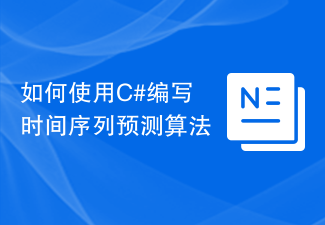 如何使用C#编写时间序列预测算法Sep 19, 2023 pm 02:33 PM
如何使用C#编写时间序列预测算法Sep 19, 2023 pm 02:33 PM如何使用C#编写时间序列预测算法时间序列预测是一种通过分析过去的数据来预测未来数据趋势的方法。它在很多领域,如金融、销售和天气预报中有广泛的应用。在本文中,我们将介绍如何使用C#编写时间序列预测算法,并附上具体的代码示例。数据准备在进行时间序列预测之前,首先需要准备好数据。一般来说,时间序列数据应该具有足够的长度,并且是按照时间顺序排列的。你可以从数据库或者
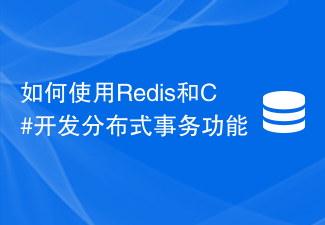 如何使用Redis和C#开发分布式事务功能Sep 21, 2023 pm 02:55 PM
如何使用Redis和C#开发分布式事务功能Sep 21, 2023 pm 02:55 PM如何使用Redis和C#开发分布式事务功能引言分布式系统的开发中,事务处理是一项非常重要的功能。事务处理能够保证在分布式系统中的一系列操作要么全部成功,要么全部回滚。Redis是一种高性能的键值存储数据库,而C#是一种广泛应用于开发分布式系统的编程语言。本文将介绍如何使用Redis和C#来实现分布式事务功能,并提供具体代码示例。I.Redis事务Redis
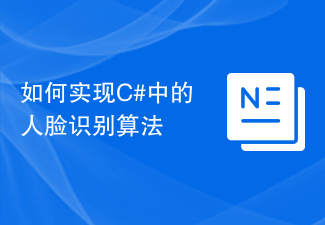 如何实现C#中的人脸识别算法Sep 19, 2023 am 08:57 AM
如何实现C#中的人脸识别算法Sep 19, 2023 am 08:57 AM如何实现C#中的人脸识别算法人脸识别算法是计算机视觉领域中的一个重要研究方向,它可以用于识别和验证人脸,广泛应用于安全监控、人脸支付、人脸解锁等领域。在本文中,我们将介绍如何使用C#来实现人脸识别算法,并提供具体的代码示例。实现人脸识别算法的第一步是获取图像数据。在C#中,我们可以使用EmguCV库(OpenCV的C#封装)来处理图像。首先,我们需要在项目
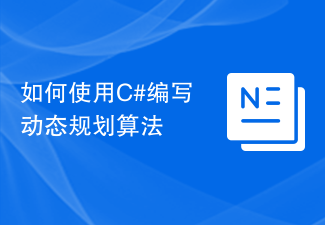 如何使用C#编写动态规划算法Sep 20, 2023 pm 04:03 PM
如何使用C#编写动态规划算法Sep 20, 2023 pm 04:03 PM如何使用C#编写动态规划算法摘要:动态规划是求解最优化问题的一种常用算法,适用于多种场景。本文将介绍如何使用C#编写动态规划算法,并提供具体的代码示例。一、什么是动态规划算法动态规划(DynamicProgramming,简称DP)是一种用来求解具有重叠子问题和最优子结构性质的问题的算法思想。动态规划将问题分解成若干个子问题来求解,通过记录每个子问题的解,
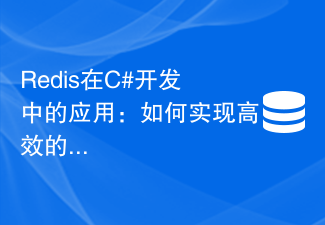 Redis在C#开发中的应用:如何实现高效的缓存更新Jul 30, 2023 am 09:46 AM
Redis在C#开发中的应用:如何实现高效的缓存更新Jul 30, 2023 am 09:46 AMRedis在C#开发中的应用:如何实现高效的缓存更新引言:在Web开发中,缓存是提高系统性能的常用手段之一。而Redis作为一款高性能的Key-Value存储系统,能够提供快速的缓存操作,为我们的应用带来了不少便利。本文将介绍如何在C#开发中使用Redis,实现高效的缓存更新。Redis的安装与配置在开始之前,我们需要先安装Redis并进行相应的配置。你可以
 如何实现C#中的图像压缩算法Sep 19, 2023 pm 02:12 PM
如何实现C#中的图像压缩算法Sep 19, 2023 pm 02:12 PM如何实现C#中的图像压缩算法摘要:图像压缩是图像处理领域中的一个重要研究方向,本文将介绍在C#中实现图像压缩的算法,并给出相应的代码示例。引言:随着数字图像的广泛应用,图像压缩成为了图像处理中的重要环节。压缩能够减小存储空间和传输带宽,并能提高图像处理的效率。在C#语言中,我们可以通过使用各种图像压缩算法来实现对图像的压缩。本文将介绍两种常见的图像压缩算法:
 C#开发中如何处理跨域请求和安全性问题Oct 08, 2023 pm 09:21 PM
C#开发中如何处理跨域请求和安全性问题Oct 08, 2023 pm 09:21 PMC#开发中如何处理跨域请求和安全性问题在现代的网络应用开发中,跨域请求和安全性问题是开发人员经常面临的挑战。为了提供更好的用户体验和功能,应用程序经常需要与其他域或服务器进行交互。然而,浏览器的同源策略导致了这些跨域请求被阻止,因此需要采取一些措施来处理跨域请求。同时,为了保证数据的安全性,开发人员还需要考虑一些安全性问题。本文将探讨C#开发中如何处理跨域请
 如何实现C#中的遗传算法Sep 19, 2023 pm 01:07 PM
如何实现C#中的遗传算法Sep 19, 2023 pm 01:07 PM如何在C#中实现遗传算法引言:遗传算法是一种模拟自然选择和基因遗传机制的优化算法,其主要思想是通过模拟生物进化的过程来搜索最优解。在计算机科学领域,遗传算法被广泛应用于优化问题的解决,例如机器学习、参数优化、组合优化等。本文将介绍如何在C#中实现遗传算法,并提供具体的代码示例。一、遗传算法的基本原理遗传算法通过使用编码表示解空间中的候选解,并利用选择、交叉和


Hot AI Tools

Undresser.AI Undress
AI-powered app for creating realistic nude photos

AI Clothes Remover
Online AI tool for removing clothes from photos.

Undress AI Tool
Undress images for free

Clothoff.io
AI clothes remover

AI Hentai Generator
Generate AI Hentai for free.

Hot Article

Hot Tools

SublimeText3 Mac version
God-level code editing software (SublimeText3)

SublimeText3 Linux new version
SublimeText3 Linux latest version

SecLists
SecLists is the ultimate security tester's companion. It is a collection of various types of lists that are frequently used during security assessments, all in one place. SecLists helps make security testing more efficient and productive by conveniently providing all the lists a security tester might need. List types include usernames, passwords, URLs, fuzzing payloads, sensitive data patterns, web shells, and more. The tester can simply pull this repository onto a new test machine and he will have access to every type of list he needs.

WebStorm Mac version
Useful JavaScript development tools

SublimeText3 English version
Recommended: Win version, supports code prompts!





